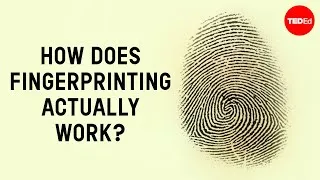请双击下面的英文字幕来播放视频。
翻译人员: Chien Yet Chong
校对人员: Riley WANG
“牙齿由坚不可摧的物质组成。
它们可以抵御洪水、大火、
甚至数世纪在墓穴中也仍旧存在。”
——玛丽·奥托,《牙齿》
00:07
You may take them for granted,
but your teeth are a marvel.
0
7021
4262
你也许不太重视它们,
但是你的牙齿是非凡之物。
00:11
They break up all your food
over the course of your life,
1
11283
3150
它们把你一生所吃的食物咬碎,
00:14
while being strong enough
to withstand breakage themselves.
2
14433
3830
与此同时却足够坚固
使自己不会损坏。
00:18
And they’re formed using
only the raw materials
3
18263
2920
组成它们的原材料
00:21
from the food they grind down
in the first place.
4
21183
3220
全部来自于起初磨碎的食物。
00:24
What’s behind their impressive strength?
5
24403
2431
是什么使牙齿拥有异常的强度?
00:26
Teeth rely on an ingenious structure
that makes them both hard and tough.
6
26834
4479
牙齿依靠其巧妙的构造
来使它们坚硬和强韧。
00:31
Hardness can be thought of as the ability
to resist a crack from starting,
7
31313
4318
坚硬可看作是
抵御出现破裂的能力,
00:35
while toughness is what stops
the crack from spreading
8
35631
3813
而强韧则表示能够
阻止破裂进一步扩散。
00:39
Very few materials have both properties.
9
39444
2894
世上极少有材料兼备这两种特性。
00:42
For instance, glass is hard but not tough,
10
42338
3876
举个例子,玻璃坚固却不强韧,
00:46
while leather is tough but not hard.
11
46214
2749
皮革则强韧却不坚固。
00:48
Teeth manage both by having two layers:
12
48963
3016
牙齿兼备两种特性
因为它由两层组成:
00:51
a hard external cap of enamel, made up
almost entirely of a calcium phosphate,
13
51979
5465
外层由坚硬的牙釉质包围,
几乎完全由磷酸钙组成,
00:57
and beneath it,
a tougher layer of dentin,
14
57444
3188
牙釉质之下,
有一层更加强韧的牙本质,
01:00
partly formed from organic fibers
that make it flexible.
15
60632
3661
部分由有机纤维组成,
它们能够使牙齿强韧。
01:04
This amazing structure is created
by two types of cells:
16
64293
3908
这奇妙的构造是由
两种细胞生成的:
01:08
ameloblasts that secrete enamel
17
68201
2794
分泌牙釉的成釉细胞
01:10
and odontoblasts that secrete dentin.
18
70995
3080
以及分泌牙本质的成牙本质细胞。
01:14
As they form teeth,
odontoblasts move inward,
19
74075
3028
在形成牙齿时,
成牙本质细胞向牙内部扩散,
01:17
while ameloblasts move out
and slough off when they hit the surface.
20
77103
4451
成釉细胞则向牙的外部生长,
并在抵达牙齿表面时脱落。
01:21
For enamel, this process produces long,
thin strands,
21
81554
4013
在生成牙釉质的过程中
会产生细长的纤维状物,
01:25
each about 60 nanometers in diameter.
22
85567
3367
每条纤维的直径宽约60纳米。
01:28
That’s one one-thousandth
the width of a human hair.
23
88934
3361
相当于人类发丝直径的千分之一。
01:32
Those are bundled into rods,
packed together,
24
92295
3400
这些物质集合成捆,
紧密地排列起来,
01:35
tens of thousands per square millimeter,
25
95695
2698
每平方毫米可达到上万个,
01:38
to form the shield-like enamel layer.
26
98393
3132
组成如盾牌般坚硬的牙釉质层。
01:41
Once this process is finished,
your enamel can’t repair itself again
27
101525
3739
一旦这个过程完成,
你的牙釉不会再自我修复
01:45
because all the cells
that make it are lost,
28
105264
3481
因为所有制造牙釉质的细胞
都已经消失,
01:48
so we’re lucky that enamel
can’t be easily destroyed.
29
108745
3479
所以,我们很幸运牙釉质
并不容易遭到破坏。
01:52
Odontoblasts use a more complex process,
but unlike ameloblasts, they stick around,
30
112224
6210
成牙本质细胞则需要更复杂的过程,
但与成釉细胞不同,它们不会消失,
01:58
continuing to secrete dentin
throughout your life.
31
118434
3411
会在我们有生之年
继续分泌牙本质。
02:01
Despite the differences in teeth
across the mammalian order,
32
121845
3331
虽然在哺乳目中
各类生物的牙齿不同,
02:05
the underlying process of tooth growth
is the same whether it’s for lions,
33
125176
4828
但是牙齿的基本生长过程则一样,
不论是狮子、
02:10
kangaroos,
34
130004
1031
袋鼠、
02:11
elephants,
35
131035
929
02:11
or us.
36
131964
1602
大象、
还是人类自己。
02:13
What changes is how nature sculpts
the shape of the tooth,
37
133566
3508
不同之处在于大自然如何塑造
牙齿的形状,
02:17
altering the folding and growth patterns
38
137074
2315
改变牙齿的折层和生长模式
02:19
to suit the distinct diets
of different species.
39
139389
3845
来契合各个物种不同的饮食习惯。
02:23
Cows have flat molar teeth with parallel
ridges for grinding tough grasses.
40
143234
5279
牛的臼齿扁平
有平行的牙脊来咬碎坚韧的草。
02:28
Cats have sharp crested molars,
like blades, for shearing meat and sinew.
41
148513
5679
猫的臼齿呈波形,如锋刃般尖锐
用来撕碎肌肉和韧带。
02:34
Pigs have blunt, thick ones,
useful for crushing hard roots and seeds.
42
154192
4891
猪有又钝又厚的牙齿,
有利于压碎坚硬的根和种子。
02:39
The myriad molars of modern mammals
43
159083
2419
现代哺乳类的臼齿千变万化
02:41
can be traced back to a common form
called “tribosphenic,"
44
161502
3769
可以追溯到一个同源形式,
叫做“磨楔式齿,"
02:45
which first appeared
during the dinosaur age.
45
165271
2701
这种牙齿最早
在恐龙时代出现。
02:47
In the 19th Century,
paleontologist Edward Drinker Cope
46
167972
3989
19世纪,古生物学家
爱德华·德林克·科普
02:51
developed the basic model
for how this form evolved.
47
171961
3481
发展出了一个基本模型
用以表示该形式的演化过程。
02:55
He hypothesized that
it started with a cone-like tooth,
48
175442
3560
他推测牙齿起初都呈尖状,
02:59
as we see in many fishes,
amphibians, and reptiles.
49
179002
3380
正如我们在鱼类、两栖类
与爬行类动物中所见到的那样。
03:02
Small cusps were then added,
so the tooth had three in a row,
50
182382
4510
后来,更小的尖端出现,
所以一颗牙齿有成排的三个尖头,
03:06
aligned front to back,
and connected by crests.
51
186892
3742
从前往后排列,并由凹槽相连接。
03:10
Over time, the cusps were pushed out
of line to make triangular crowns.
52
190634
4890
随着时间推移,这些尖端
逐渐移位,形成了三角形的牙冠。
03:15
Adjacent teeth formed a continuous
zigzag of crests for slicing and dicing.
53
195524
5669
相邻的牙齿则形成连贯性的
之字形的凹槽,
用来切碎和咬碎食物。
03:21
A low shelf then formed
at the back of each set of teeth,
54
201193
3921
之后,每颗牙齿的后部
都形成了一个低牙架,
03:25
which became a platform for crushing.
55
205114
2607
这为压碎食物提供了一个平台。
03:27
As Cope realized, the tribosphenic molar
served as the jumping-off point
56
207721
4824
科普意识到,以磨楔式臼齿
这一模式作为跳板,
03:32
for the radiation of specialized
forms to follow,
57
212545
3349
大量不同的牙齿形式在此基础上衍生,
03:35
each shaped by evolutionary needs.
58
215894
2498
每种牙齿的塑造都由进化的需求完成。
03:38
Straighten the crests
and remove the shelf,
59
218392
2507
把凹槽拉直,移除牙架,
03:40
and you’ve got the conveniently
bladed teeth of cats and dogs.
60
220899
3604
你就得到猫狗的尖齿。
03:44
Remove the front cusp, raise the shelf,
and you’ve got our human molars.
61
224503
5832
移除前尖端,提升牙架,
你就得到我们人类的臼齿。
03:50
A few additional tweaks get you
a horse or cow tooth.
62
230335
3690
轻微扭转调整,
你就可以得到马或牛的牙齿。
03:54
Some details in Cope’s intuitive
hypothesis proved wrong.
63
234025
4209
在科普凭直觉提出的推论中,
有些细节是错误的。
03:58
But in the fossil record,
64
238234
1201
但是化石记录显示,
03:59
there are examples of teeth
that look just as he predicted
65
239435
3729
有些牙齿样本与他推测的一样
04:03
and we can trace the molars of all living
mammals back to that primitive form.
66
243164
5111
并且所有哺乳生物的臼齿
也可以追溯到那个原始形式。
04:08
Today, the ability to consume
diverse forms of food
67
248275
3468
如今,哺乳类动物
可以摄入多元化食物
04:11
enables mammals to survive in habitats
68
251743
2376
这种能力使它们
可以在多种栖息地生存,
04:14
ranging from mountain peaks
and ocean depths
69
254119
2926
从高山顶峰到深海底层
04:17
to rainforests and deserts.
70
257045
2224
从热带雨林到炙热沙漠。
04:19
So the success of our biological class
is due in no small measure
71
259269
4436
所以,我们所属的哺乳纲动物
之所以成功,
大部分要归功于
04:23
to the remarkable strength
and adaptability
72
263705
2590
不起眼的哺乳类臼齿所具有的
惊人的强度和适应性。
04:26
of the humble mammalian molar.
73
266295
2500
New videos
关于本网站
这个网站将向你介绍对学习英语有用的YouTube视频。你将看到来自世界各地的一流教师教授的英语课程。双击每个视频页面上显示的英文字幕,即可从那里播放视频。字幕会随着视频的播放而同步滚动。如果你有任何意见或要求,请使用此联系表与我们联系。







